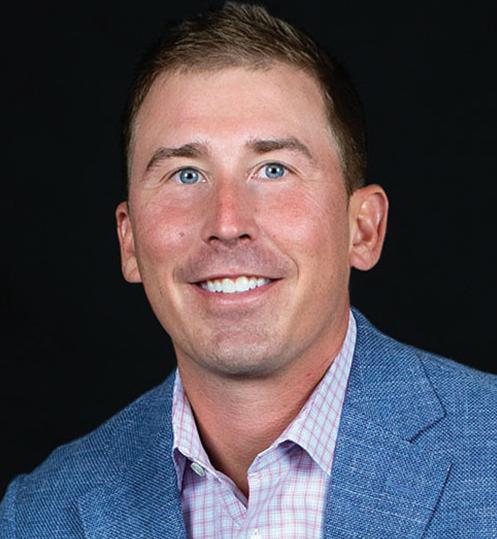
22 minute read
The Portfolio
Consumer Products M&A— How to Come Out Looking Great
Advertisement
Charles Morton
Co-Chair, Corporate Group, Venable LLP A s the M&A market enjoys unprecedented levels of activity, no sector has been more volatile than consumer products. With changing buying patterns, wild swings in consumer spending, and fear shifting toward wild optimism, the sector has been impacted by recent events in profound ways. Throw in a healthy fear of increasing taxes and you have the recipe for a wild, and very busy, ride.
The middle-market deal community is as busy as ever. Record levels of dry powder, low interest rates, rosy predictions of growth, a maturing private equity community and aging founders are fueling a sprint in activity. Many service providers have reached, or are nearing, capacity. These anecdotes, however, are not yet fully reflected in the data.
The apparent current level of activity contrasts from a generally weak 2020, particularly in the second and third quarters. For example, 2020 saw a 15% drop in consumer product-related transaction value compared to 2019, according to Bain & Co. There were, however, clear winners and losers in the world of COVID. For example, growing throughout 2020 were deals focused on insurgent brands—those brands outpacing category growth—for which acquirers were prepared to pay a premium. Even in last year’s relatively anemic market, such deals continued the same two- to threefold annual growth that they’ve experienced since 2015.
Capturing the Special Sauce
Identifying and capturing the economic driver of the target is at the heart of what any buyer must prioritize. For consumer product companies, often it takes a special mix of attributes to ensure success. The quality of the products themselves is clearly part of the story. The supply chain that ensures consistency, a strong manufacturing/production infrastructure, and a way to ensure ongoing product development and enhancement are essential. After production, sales channels that provide for sufficient avenues to market and appropriate price points are equally important. A team to ensure execution and a clear articulation of what sets the business apart, or brand identity, is also required.
In the midst of a robust market, where valuations are frothy, the need for buyers to perform adequate diligence could not be greater. One simple miss anywhere along the diligence journey could turn likely gains into losses. Where there is pressure to close the deal as promptly as possible, care is required, as are partnerships with supportive professionals to assist in analysis and deal execution.
As a seller, pre-sale preparation has never been more important. Seller-funded quality of earnings reports before instituting the sales process, audited financials (even if not done historically), buttoned-up key contracts, a list of all contracts requiring consent, and general corporate house cleaning can all help to speed the transaction.
On the buy-side, peeling through the numbers to be certain you are not paying for results that may have been an anomaly must be a central concern. In addition, for many consumer products, from food to health-related products, to anything manufactured overseas, the regulatory landscape continues to evolve rapidly. Understanding the current rules, and anticipating changes that may be coming, must be part of the analysis in any transaction.
In the world of consumer products M&A, deals are happening and, when done well, both the buyer and the seller can come out looking great. //
Charles Morton is a co-chair of Venable’s Corporate Group and a past chairman of ACG.
Supply Chain: Moving Past the Global Pandemic
MID-MARKET TRENDS // How to address enduring supply chain challenges and disruptors
Anthony Casciano
President and CEO, Siemens Financial Services, Inc.
Bruce McIndoe
Founder, WorldAware and McIndoe Risk Advisory I n 2020, global supply chain vulnerabilities were exposed by the COVID-19 pandemic, disrupting manufacturing and provoking conversations about resiliency. The question was continuously raised: How do we ensure supply chains are reliable going forward? And if the pandemic wasn’t enough to fuel a revision of the global supply chain, the March 2021 incident that left a massive container ship blocking the Suez Canal in Egypt for nearly a week was an extra nudge toward upgrades.
As we ease into a new version of normalcy with the slowing of the COVID-19 pandemic thanks to the growing availability of vaccines, the permanent influence of this global shock on our supply chain and emerging supply chain disruptors such as resource scarcity, climate change and congestion come into play.
Population growth will pose a significant challenge for the supply chain going forward. There are currently around 1.2 billion housing units in the world. To satisfy the growth trajectory of our population, we need 1 billion more housing units built in the next 30 years. This growth affects other resources as well, such as food and water, and raises concerns surrounding the connection between economic growth and natural resource use.
Rather than dwelling on these disruptors, it’s important to understand how best to navigate them and the solutions that already exist, or are in development, to diminish their negative impact.
Along with the challenges that our supply chain faces, this understanding begins with realizing how the supply chain will change for the better going forward. Historically, trade has occurred horizontally from east to west due to how civilization developed and in modern times, where wealth resides in the United States and Europe. In the coming years, due to the rise of foreign nations, we can expect to see a transition to vertical trading from north to south. This hemispherical shift in supply chain will cause de-globalization and the Western Hemisphere will in theory become self-reliant, putting less strain on the supply chain.
The technology needed to strengthen the supply chain is already in existence or development and includes advanced farming, power generation and storage technology, modular recyclable materials, robotics and more. For energy, health care and industrial companies, Siemens enables upgrades to new technology along with the financing needed to empower new business models and solutions.
While there are many challenges and disruptors facing the global supply chain, there are also reasons for hope. As more companies adopt new technology and digitalize their operations, the supply chain will become more adaptive and resilient. //
TECHNOLOGY AND DIGITALIZED OPERATIONS WILL ENABLE MORE ADAPTIVE AND RESILIENT SUPPLY CHAINS.
Anthony Casciano is president and CEO of Siemens Financial Services, Inc. He also leads its IoT efforts in the United States.
Bruce McIndoe is founder of WorldAware and McIndoe Risk Advisory.
This article is a follow-up to the July 2020 article by Anthony Casciano: “Adapt Your Supply Chain to New Realities.”
The Case for Investing in Early Childhood Education
By Candace Adorka
Mark Gartner is a father of two young children; he’s also head of investment development at Clearlight Partners, a private equity firm. Gartner drew inspiration from his own life to develop an investment thesis around private preschools.
“Generally speaking, a well-managed mature school can generate $2-3MM of annual revenue with 20-30% EBITDA margins. If you assume a build-out cost of $500K-1MM, then there is good rationale to grow via a greenfield, or de novo, strategy,” Gartner writes.
His confidence in this market was virtually unshakable as he developed it early last year—then the pandemic happened. By August, 20% of childcare workers were out of a job, and 80% of childcare providers were expected to close permanently. The federal government has since bolstered the industry, and unemployment rates are ticking down—indicators that bode well for a strong recovery for the childcare industry.
Procare Solutions provides business management software to childcare companies. The company polled its 30,000 users to track how the industry is responding to the pandemic. According to its March report:
ɋ 60% of centers closed after March 2020 ɋ 76% of those centers have now reopened
Centers are operating at 58% of their pre-pandemic capacity, the highest point since bottoming out at 13% last April.
Procare’s user data suggest the childcare industry is recovering, especially in states that are experiencing a population boom. Idaho, for instance, is at 94% of centers reopened at 75% capacity. This is in line with what Derek Cummings—head of the Creation Village school in Florida—is seeing in his community: “Here in Florida, because unemployment is so low, the market is back. Our demand and waitlists are growing each day. We have a high volume of interest, and I think the market is definitely back from what some of the centers we know of are saying.”
Cummings goes on to explain why he’s bullish about the future of the industry: “I do believe that there is a strong movement within policy, whether it be from a state level or federal level, to support people going back to work and having a place for their child. … I think the market is going to continue to grow and strengthen. I also believe that you will see a lot more corporate partnerships working with centers themselves.”
DEREK CUMMINGS
Head of School, Creation Village
CONTINUED ON PAGE 52
CONTINUED FROM PAGE 50 For investors who agree with Cummings’ outlook and are ready to investigate the market, Gartner gives detailed advice about the characteristics to look for in a target. Some of his criteria have been used to
OWNERSHIP
98% Independent
1
PE platform
3
Private subsidiary
ACCREDITATION
91

All accreditations
PEDAGOGIES
107
Montessori
27
NAYEC accredited
4
Bradford Early Education
11
Reggio Emilia
4
Waldorf
3
Bank Street filter within the Grata search platform, giving a sense of how many potential targets exist in the North American market.
The baseline search found 395 companies with two or more locations.
MULTI-SITE PRESENCE
2+ locations
3+ locations
4+ locations
5+ locations
395 104 76 48
REPUTATION
40 Boast their good reputations or high ratings on their websites
This article was adapted from the Next Target newsletter, which features forward-looking analysis of niche industries. Next Target is part of a partnership between ACG and Grata, a search engine for companies.
QBE
Food Product Manufacturers Shift to Post-Pandemic World
Insurer QBE and broker Lockton partner to help address the labor shortage and other concerns as the U.S. economy recovers
While many consumer food product manufacturers fared well during the COVID-19 crisis compared with companies in the hospitality, retail and airline industries, they did see their risks change and grow. With more people eating at home more often, for instance, many saw demand rise but struggled to find enough workers. That struggle continues as the economy recovers.
“The labor shortage has become one of the primary concerns for our consumer food product customers,” explains Tom Fitzgerald, president of Specialty & Commercial Insurance at QBE North America. “To help them solve for this and other risks, we partner with a select group of insurance brokers, leveraging each other’s strengths to bring value to clients as trusted advisors.”
The long-term partnership between QBE North America and Lockton Companies is one example.
“As a broker, our job is to find the best risk management and insurance partner for our clients,” explains Matthew Klein, senior vice president and team leader, Food and Beverage Practice, Lockton Companies. “We take a holistic view of a customer’s risks and then see how our complementary products and services can help them navigate those risks.”
Regarding the labor shortage, Lockton’s services include analyzing the competitiveness of a customer’s employee benefits package against those of rival employers in the area, notes Klein. Lockton also surveys employees about what is most important to them to help companies optimize how they spend on employee benefits and the workplace environment to improve employee retention.
WORKER SAFETY
Those services work in tandem with services provided by QBE as part of the insurance program.
“Worker safety is always a top concern at manufacturers, where injuries tend to be more frequent and severe compared to many other industries,” says Bobby Steinsdoerfer, senior vice president, Retail P&C Underwriting, QBE. “It’s a big part of keeping staff morale high and the workforce at full capacity. It also affects a major portion of the overall insurance premium spent by manufacturers. Therefore, anything we can do to improve safety pays significant dividends.”
In one case, QBE performed a loss control survey for a coffee manufacturer that uncovered increased risk due to various manual lifting tasks, such as loading 8-foot-tall plastic silos with heavy equipment in a confined space, as well as manually moving 150-pound bags of coffee beans. These were a leading cause of sprain and strain injuries.
Based on that finding, QBE conducted onsite Job Hazard Analysis supervisory training that included a safe lifting program, online courses and ergonomic risk assessments on a variety of tasks. Within about two years, the program cut the coffee manufacturer’s Workers’ Compensation loss ratio roughly in half.
“Midsize manufacturers may not have the scale to have a dedicated risk management function,” says Steinsdoerfer. “The services we provide in concert with our broker partners such as Lockton can help these manufacturers improve worker safety and thereby reduce labor supply issues.”
BOBBY STEINSDOERFER
Senior Vice President, Retail P&C Underwriting, QBE
WORK CULTURE AND BRAND REPUTATION
In addition to employee benefits and worker safety, QBE and Lockton note that companies face increased
pressure on maintaining a fair and respectful work culture to attract and retain employees and protect their brand reputation.
“While culture and brand reputation have always been important issues, movements such as #MeToo and Black Lives Matter have elevated sensitivity to discrimination and harassment issues, so employers have to get this right,” notes Fitzgerald. “The problem for midsize manufacturers is the lack of robust legal and HR departments to implement strong policies and procedures and stay on top of constantly evolving regulations.”
While Employment Practices Liability insurance can provide coverage for costs related to legal defense, settlements or jury awards to employee claimants, and even public relations costs, the best defense is to avoid issues in the first place.
To help, employers who purchase Employment Practices Liability insurance from QBE also get access to a complimentary service that offers unlimited documented and confidential advice from employment law attorneys, online training courses on topics such as sexual harassment prevention, a state-specific employee handbook and policy builder, and federal and state regulatory updates.
PLANNING TO INCREASE AUTOMATION
In another effort to combat the labor shortage and improve efficiency, food manufacturers have ramped up efforts to automate the production process, but the acceleration of this trend brings new risks. Cyber vulnerability is one, especially with the increased use of the Internet of Things (IoT)— devices and sensors that monitor and control equipment or processes.
“Food manufacturers weren’t heavy buyers of cyber insurance early on because, unlike health care or financial services companies, they didn’t keep a lot of sensitive customer information that was a common target in early cyber breaches,” Klein notes. “For the same reason, they were slower to adopt strict IT controls. But the proliferation of ransomware attacks has changed all that—as the recent shutdown of meat processor JBS showed. We work closely with customers to evaluate their risks, suggest resources for strengthening their controls and response plans, and secure proper insurance coverage.”
Beyond cyber risk, Steinsdoerfer notes the importance of broker-carrier teamwork to stay on top of equipment that is brought in for increased automation throughout the insurance policy term. This equipment can be very expensive and insurance values need to be adjusted accordingly. Furthermore, physical labor tasks may change with new automation and require a new assessment of ergonomic risks.
Labor supply, brand reputation and cyber vulnerability are just three of the many challenges facing food manufacturers today. QBE and Lockton also see growing concern about inflation, supply chain and regulatory actions. By working closely together to understand these risks from the customer viewpoint, they can tailor an insurance program and related services to help customers move forward with confidence toward a post-pandemic world.
QBE North America is part of QBE Insurance Group Limited, one of the largest insurers and reinsurers in the world. Lockton is the world’s largest privately owned independent insurance brokerage firm. // TOM FITZGERALD

President of Specialty & Commercial Insurance at QBE

BOBBY STEINSDOERFER
Senior Vice President, Retail P&C Underwriting, QBE

MATT KLEIN
Senior Vice President and Team Leader, Food and Beverage Practice, Lockton Companies
DICKINSON + ASSOCIATES
Maximizing the Value of M&A Through Technology
Every merger and acquisition is unique. But that doesn’t mean growing middle-market firms need to reinvent the wheel for every acquisition. Instead, Pregis LLC relies on an acquisition playbook and SAP technology to support rapid integration and standardization. Using a playbook, Pregis has completed acquisitions in as little as 90 days.
Pregis, a leading manufacturer and provider of protective products and innovative packaging solutions, is growing aggressively with acquisitions as its core strategy. The firm, sponsored by global private equity firm Warburg Pincus since 2019, has completed eight acquisitions in only six years with a topend value of $100 million.
Through its acquisitions, Pregis has shifted from a product-based company to a solutions- and services-based company in different verticals and go-to-market channels. Most recently, Pregis acquired the technology to manufacture the EverTec® mailer and also opened a 300,000-square-foot facility to expand manufacturing capacity with plans for two more facilities.
In addition to manufacturing and products, Pregis’ IQ Center, located in Illinois, provides a collaborative physical environment in which customers work through business challenges and solutions. The firm leverages learnings from customers to continually enhance their platform.
CREATING VALUE FOR PE FIRMS QUICKLY
To drive value to private equity owners as soon as possible, acquisition speed is critical. To help it integrate its acquisitions seamlessly and meet its growth goals, Pregis turned to Dickinson +Associates, an SAP Gold Partner. Dickinson + Associates helps clients analyze challenges and goals and then recommends SAP solutions and other services based on this analysis.
For Pregis, Dickinson + Associates recommended the SAP S/4HANA platform as the best digital solution for Pregis’ platform-based approach to market growth and expansion. It’s been an excellent fit. “We can customize our SAP platform to fit our business as our needs change or to meet unique requirements. The platform is easy to scale up, add to or expand,” says Jeffrey Mueller, vice president and CIO, Pregis. “SAP is the digital core that glues our acquisitions together and supports our aggressive growth strategy.”
Dickinson + Associates, a Navisite company, has been a full-service SAP partner for more than 20 years, providing its clients with end-to-end support, from initial engagement to selecting the right software to integrating the platforms and post-deployment optimization.
Flexibility and nimbleness are key characteristics of the SAP platform, notes Brad Wolfe, vice president, corporate development, Dickinson +Associates. That flexibility is a key benefit for Pregis. “Our core processes are incorporated into our acquisition template, but the platform is flexible so that we can adjust the template as our business needs change,” adds Mueller.
JEFFREY MUELLER
Vice President and CIO, Pregis
Information is power, and with a consistent data model, Pregis is now able to access data across the enterprise and is confident that data is secure against cyberattacks or security breaches.
BEYOND TECHNOLOGY
Pregis relies heavily on its technology platform when sizing up a potential acquisition. “One of our most important considerations is to make sure that we have the ability to leverage the platform and its touchpoints,” Mueller says. “The platform allows us to get the entire acquisition right and integrate not only the technology but people and processes as well.”
Pregis leaned on Dickinson + Associates to make sure that SAP suited their needs perfectly. Pregis had been on an early version of SAP’s HANA platform and the company was concerned that they needed to upgrade. Dickinson + Associates put Pregis in touch with the appropriate people at SAP and ensured that Pregis would get the support they needed.
Technology acumen wasn’t the only reason Pregis chose to partner with Dickinson + Associates. The ability to solve business challenges and grow revenue by streamlining and standardizing processes was critical. “The Dickinson team has excellent business skills in addition to technology expertise,” Mueller says. “We have long-tenured employees who are used to doing things a certain way. Dickinson helped us with change management and getting people on board with new processes.”
Dickinson + Associates brought a diverse team with the right skills to the engagement. Teams remained largely the same through multiple acquisitions, lending consistency and an intimate knowledge of Pregis’ strategies and goals to each acquisition, notes Mueller.
STRATEGIES TO DELIVER VALUE FAST
Every middle-market company approaches M&A differently. Wolfe recommends that firms stick with best practices and develop a strong methodology to standardize and optimize processes and data structures. “You need a proven process that can support integration speed,” Wolfe explains.
A playbook is invaluable. The vision for the playbook starts at the top. “The playbook ensures alignment on the goals of the entire organization,” Wolfe says. “Once you have alignment, you can execute by following the playbook.”
Mueller suggests that middle-market companies approach acquisitions methodically using a step-by-step approach. And each acquisition should have its own timeline based on its unique attributes. However, it’s important to take it slow. “Implement technology in phases instead of trying to do everything all at once,” he says.
Taking it slow also minimizes risk. “In the beginning, keep it simple. Complete the integration quickly and once the initial integration is done, use technology to continually innovate and improve,” Mueller recommends.
Lastly, look for a partner that understands your business and the nature of M&A. “Acquisitions can come at you fast and can be difficult to plan for. Once you have the building blocks right, you can better roll out acquisitions that meet your business imperatives,” Wolfe says. // BRAD WOLFE

Vice President, Corporate Development, Dickinson + Associates
PREMIKATI, INC.
A Trusted Procurement Partner
Premikati harnesses SAP Ariba software to meet clients’ buying needs
Procurement is a complex process for all businesses, with midmarket firms facing the same challenges in managing spend and suppliers as their larger peers. While procurement can require substantial resources to navigate, Premikati, Inc. is busy streamlining the often-chaotic operation for its midsize clientele.
Utilizing SAP Ariba software, the Indianapolis-based consulting company allows customers to control spending, cutting through tedious paperwork and PDFs by automating each step of the buying process.
“We think of ourselves as a procurement/contract management organization,” says Chad Buchanan, COO and general counsel at Premikati. “We look at your processes and your pain points, and help figure out a better path forward.”
Part of that guidance is an investment in technology, namely an integrated SAP Ariba procure-to-pay solution. Staffed by a team of certified Six Sigma Black Belt experts, Change Masters and procurement professionals, Premikati offers a range of business and legal outsourcing services all harnessing SAP Ariba technology.
A SIMPLE-TO-USE SYSTEM
Premikati is a global SAP Ariba BPO partner, using the software to perform contract management services for large enterprise companies as “WE THINK OF OURSELVES AS A PROCUREMENT/CONTRACT MANAGEMENT ORGANIZATION. WE LOOK AT YOUR PROCESSES AND YOUR PAIN POINTS, AND HELP FIGURE OUT A BETTER PATH FORWARD.”

CHAD BUCHANAN
COO and General Counsel, Premikati
well as entities accruing under $500 million in annual revenue.
One of Premikati’s more recent additions to its client roster is Care Purchasing Services (CPS), a national group purchasing organization (GPO) dedicated to the senior living market. As a GPO servicing approximately 2,000 member organizations, aggregating purchasing volume with manufacturers, distributors and other vendors is vital to company success.
CPS connects members to hundreds of carefully vetted vendors in plant operations, food service, medical supplies and other industries. Bringing value-added programs to thousands of organizations nationwide—a strategy that includes consulting on every detail of procurement—necessitates both transparency and efficiency in the buying process.
Enter Premikati, which helped CPS implement a suite of SAP Ariba Spend Analysis software. Through this technology, CPS can easily gather and classify spend data based on updated company and industry standards. Spend visibility equates to more confident buying decisions, thanks to unique features allowing CPS to track marketplace development and compare spend to competitors.
“[SAP Ariba] rolls up that data, and CPS can use our sourcing tool to run RFP and reverse action to find better pricing,” Buchanan says. “By using overall combined spend, they can negotiate better deals.”
Put simply, CPS owns the system, while Premikati maintains its daily upkeep. Buchanan compares the CPS version of the tool to workplace sharing, where multiple companies use the same conference room.
“That’s how the SAP Ariba marketplace works—CPS can have their members use the tool as well,” Buchanan says. “They’re utilizing best-in-class Ariba software to do this work, without each individual organization having to buy their own instance of Ariba.”
Additionally, smaller CPS member enterprises won’t need the full software suite, which can cost upwards of $100,000 annually.
Buchanan says, “What’s really unique is that a company not ready to buy their own version of the system can still utilize it from an organization like CPS. They’re not getting every feature, but are still able to make purchases and get the best pricing. It’s great to share Ariba instances across multiple buying organizations, where the top organization already has set suppliers and pricing.”
The CPS version of SAP Ariba is a proof of concept, with rollouts across the member base tabbed for this year into 2022. As for Premikati, the company enjoyed a three-year growth rate of 600% prior to 2020, a jump Buchanan attributes to his firm’s partnership with enterprise application software leader SAP, which dates back to 2015.
Launched in 2009, Premikati continues to pursue private equity, a space that Buchanan believes is ripe for the marketplace approach bolstered by SAP Ariba innovations.
“Getting that approach to work well for a variety of different companies is our top focus,” he says. “We’re also going after new clients for SAP Ariba, with a goal of doubling sales from 2020. 2021 will be a significant growth year for us.” // CHAD BUCHANAN

COO and General Counsel, Premikati









